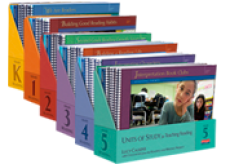Units of Study FAQ
The TCRWP has created several videos to give you and your colleagues a window into the Units of Study for Teaching Reading series. These videos are designed to support teachers, coaches, principals, and district leaders in your implementation of the Units of Study.
We have created free orientation sessions for each grade level about the Units of Study in reading that you will teach across the school year. These sessions provide an overview of the year and of reading workshop in general, and they describe the design and specifics of each unit, providing you tips while you study the books with your colleagues and implement this curriculum. Soon, we will be adding free orientation sessions for the Units of Study for Teaching Writing Series K-8.
Click here to go to the free orientation sessions for teaching reading.
We have also created a set of short clips that feature the co-authors of the Units of Study, to address some of the big questions you may have about implementing the Units, such as: Why do a reading workshop? How is explicit instruction woven in throughout the Units? How are learning progressions used to raise the level of student achievement? We hope that as you scroll through the FAQ and watch these informative clips, you will come away with a better understanding of reading workshop, reading development, ways to support teachers in using the units of study, and how to address specific needs of students at different grade and reading levels. For more information on purchasing the Units of Study. Please click here:.
Overview and FAQs
Why do a reading workshop?VIDEO | 1:58
How is explicit instruction woven throughout the Units?VIDEO | 2:05
How are the Learning Progressions used to raise achievement?VIDEO | 1:48
How can admins support communities of learning in their schools?VIDEO | 2:35
How are the reading and writing units connected?VIDEO | 2:33
How are tools used to support instruction and engage students? VIDEO | 5:50
How are nonfiction reading skills developed across the intermediate units? VIDEO | 17:16
More Frequently Asked Questions
Overview
- Series Overview (Pam Smith, 19:03)
- Why do a reading workshop? (Lucy Calkins, 1:59)
- What is different in the new Units of Study for Teaching Reading? (Lucy Calkins, 1:11)
- How are the reading and writing units connected? (Katie Clements, Kelly Boland Hohne, 2:33)
- What is the basic structure of the Units of Study for Teaching Reading? (Lucy Calkins, 2:06)
- How is explicit instruction woven throughout the Units? (Lucy Calkins, 2:04)
- How are the Learning Progressions used to raise the level of students’ reading in grades 3-5? (Lucy Calkins, 1:48)
- What are some examples of reading units that directly align with writing units? (intermediate grades) (Katie Clements, Kelly Boland Hohne, 5:15)
Getting Started
- Advice for unpacking your new units box. (Lucy Calkins, 1:34)
- Practical advice for ramping up in your first year with the units. (Lucy Calkins, 3:39)
Grade-Level Support
- How do the units help kindergarteners get started learning to read? (Natalie Louis, 3:00)
- How does instruction progress across the kindergarten units? (Natalie Louis, 2:44)
- How does instruction progress across the first grade units? (Elizabeth Dunford Franco, 2:53)
- How is reading developed across the second grade units? (Amanda Hartman, 5:51)
Support for Specific Topics
- How do the primary reading units teach the reading process? (Natalie Louis, 1:32)
- How are students supported in applying word study learning in the units? (Katie Wears, Lindsay Barton, 3:35)
- How are tools used within the units to support instruction and engage students? (Elizabeth Dunford Franco, Marjorie Martinelli, 5:50)
- How is shared reading addressed in the units? (Lauren Kolbeck, Angela Baez, 1:46)
- How is read-aloud supported within the units? (Lauren Kolbeck, Angela Baez, 2:11)
- How are nonfiction reading skills developed across the intermediate units? (Katie Clements, Kathleen Tolan, 17:16)
- How is character taught across the units? (Katie Clements, Kathleen Tolan, 12:28)
- What should teachers think about as they set up classroom libraries? (Lauren Kolbeck, Angela Baez, 2:09)



